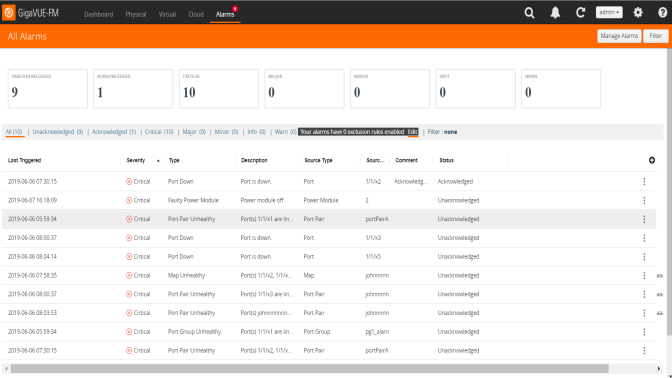View Alarms
To view the alarms triggered in GigaVUE-FM:
| 1. | Click Alarms on the top navigation bar. |
The Alarm page appears with widgets for the following alarm categories:
| • | Unacknowledged |
| • | Acknowledged |
| • | Critical |
| • | Major |
| • | Minor |
| • | Warning |
| • | Information |
| 2. | Click on each of the widget to view the list of alarms belonging to that specific category. |

The following table describes the parameters displayed in the alarm list view:
|
Permission Level |
Description |
||||||
|
Last Triggered |
The time when the alarm was last triggered. |
||||||
|
Severity |
The severity status of the alarm. This can be critical. major, minor, warning or info. |
||||||
|
Type |
The type of event that generated the alarm. For example, Faulty power module, Unhealthy map, and so on. |
||||||
|
Description |
The description of the alarm type in detail. |
||||||
|
Source Type |
The source type that triggered the alarm, e.g. port, power module, fan. |
||||||
|
Source ID |
The ID of the resource associated with the alarm. Note: You can hover your mouse on the source id to view the cluster-id, source name and alias name for the ports that have an alias. |
||||||
|
Comment |
Comment added/updated by the user for the alarm. |
||||||
|
Status |
The status of the alarm. Can be:
|
| 3. | Select an alarm and click the ellipsis to: |
| • | Acknowledge: To acknowledge an alarm. If you select this, a confirmation dialog appears saying that once you acknowledge an alarm you cannot unacknowledge the same. Click acknowledge to proceed. |
Note: This option is available only for unacknowledged alarms.
| • | Add Comment: To add a comment while acknowledging an alarm. |
| • | View Details: To view the details of an alarm such as alarm type, severity, description and other details. |
Note: Right-click the Last Triggered time to view the options mentioned above and perform the corresponding actions.



